This post may contain affiliate links. See my disclosure policy.
Made with a hearty blend of juicy chicken, spicy andouille sausage, and cooked rice, this easy one-pot Jambalaya Recipe packs bold, rich, and comforting Cajun flavors into every delicious bite! Customizable and surprisingly easy to make, this is hands-down the best jambalaya recipe you’ll ever make.
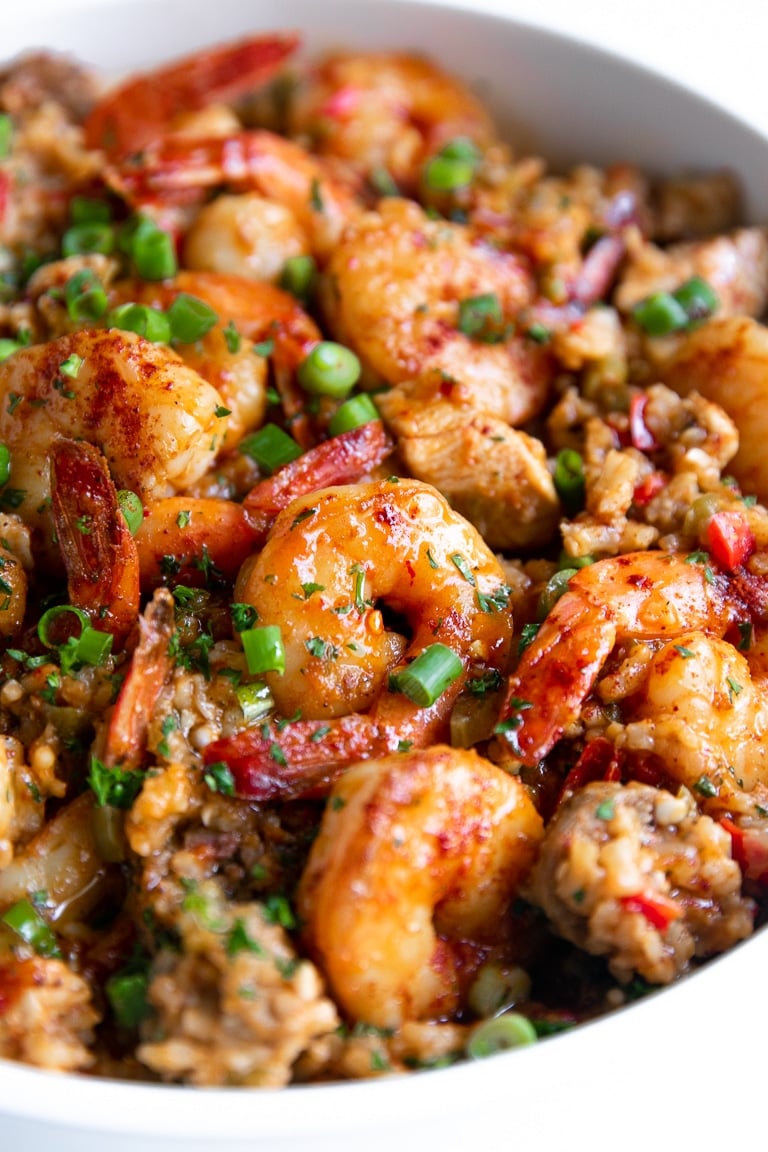
About This Recipe
Spicy, smoky, and intensely satisfying, jambalaya is a classic Louisiana feel-good food perfect for feeding a large crowd. In this version, you’ll find chopped onion, celery, bell peppers, juicy chicken, shrimp, andouille sausage, and delicious Cajun-spiced tomato rice. If you’ve never made jambalaya before, it may seem intimidating to make, but I promise it’s actually quite the opposite. Plus, you can customize it to make it your own – add your favorite meat, seafood, more or less veggies, etc. Check out the “About the Ingredients” section below for more information.
- Heat: This jambalaya recipe is very spicy. If you’re sensitive to spicy foods, omit the cayenne powder and red chili flakes.
- Difficulty: Easy (with lots of steps) – if this is your first time making jambalaya, set aside at least 90 minutes to make it.
- Freezer-Friendly: Yes. However, freezing and thawing may cause the shrimp (if included) to become rubbery and chewy, and the rice may become mushy.
- #1 Tip: Use the right type of rice. This includes long-grain rice such as jasmine or basmati, which hold their shape and are less starchy than short-grain rice.
Featured Comment
“This was amazing… even my kids couldn’t stop eating it! I only left out the okra and cayenne and it turned out perfect!“
– Jennifer
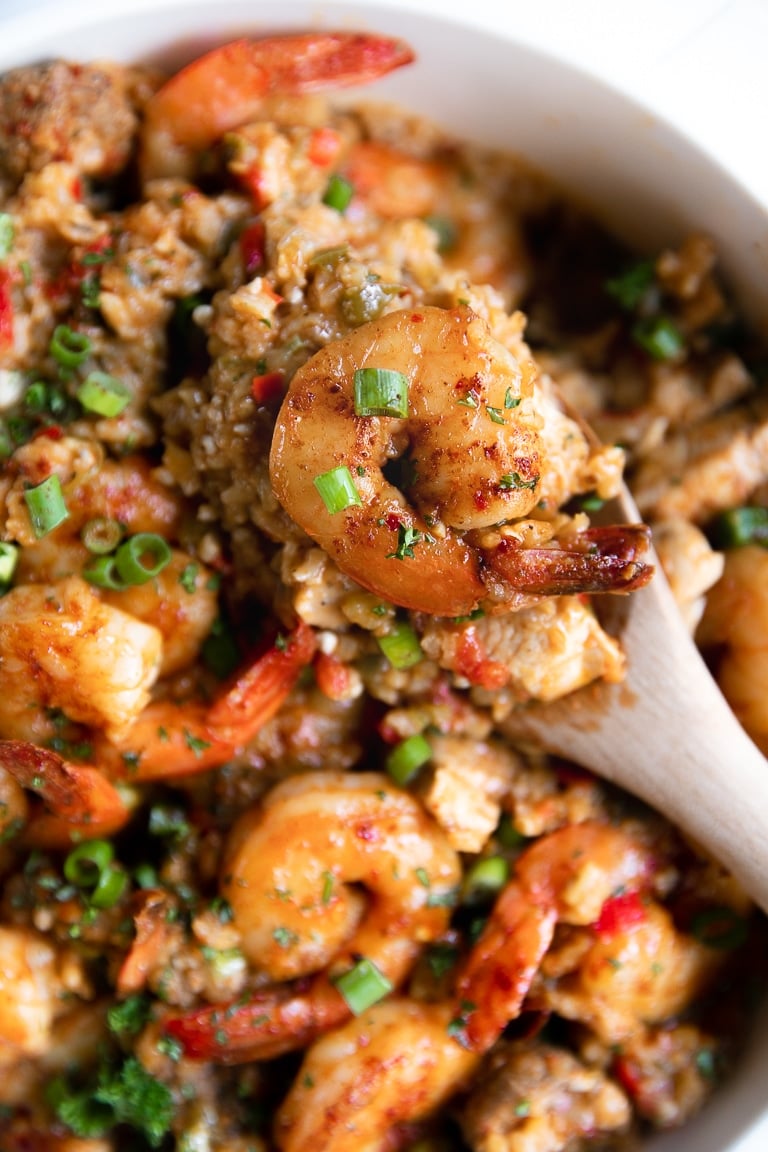
Table of Contents
What is Jambalaya?
Jambalaya is a hearty, one-pot rice dish from Louisiana with roots in Spanish, French, and African cuisines. It includes a mixture of vegetables known as the “Cajun holy trinity” or simply “trinity” that consists of slowly cooked onion, celery, and green bell pepper. You’ll also find a mixture of meats, rice, and flavorful spices. Traditional jambalaya recipes are made with a higher ratio of rice to vegetables and meat.
There are two main categories of jambalaya: Cajun and Creole. Here’s an overview of their differences:
- Creole Jambalaya (“Red Jambalaya”): Creole Jambalaya includes tomatoes, which give it its reddish color and slightly sweet, tangy taste. Popular proteins include Andouille sausage, chicken, shrimp, or crawfish, which are typically cooked with the “Cajun holy trinity” (onion, bell pepper, and celery).
- Cajun Jambalaya (“Brown Jambalaya”): Unlike Creole Jambalaya, this version does not contain tomatoes. The meat (typically Andouille sausage, chicken, pork, duck, or alligator) is browned in the pot first, leaving bits of meat stuck to the bottom, giving this version a deep brown color with lots of delicious smoky and caramelized flavoring.
What Type of Jambalaya is This Recipe
This recipe combines Creole and Cajun flavors and methods. It includes tomatoes and shrimp (Creole) but browns the meat (Cajun).
What about the okra? Okra is not authentic to traditional Cajun or Creole Jambalaya. I love the taste, so I added it. Okra is typically used in gumbo as a thickening agent.
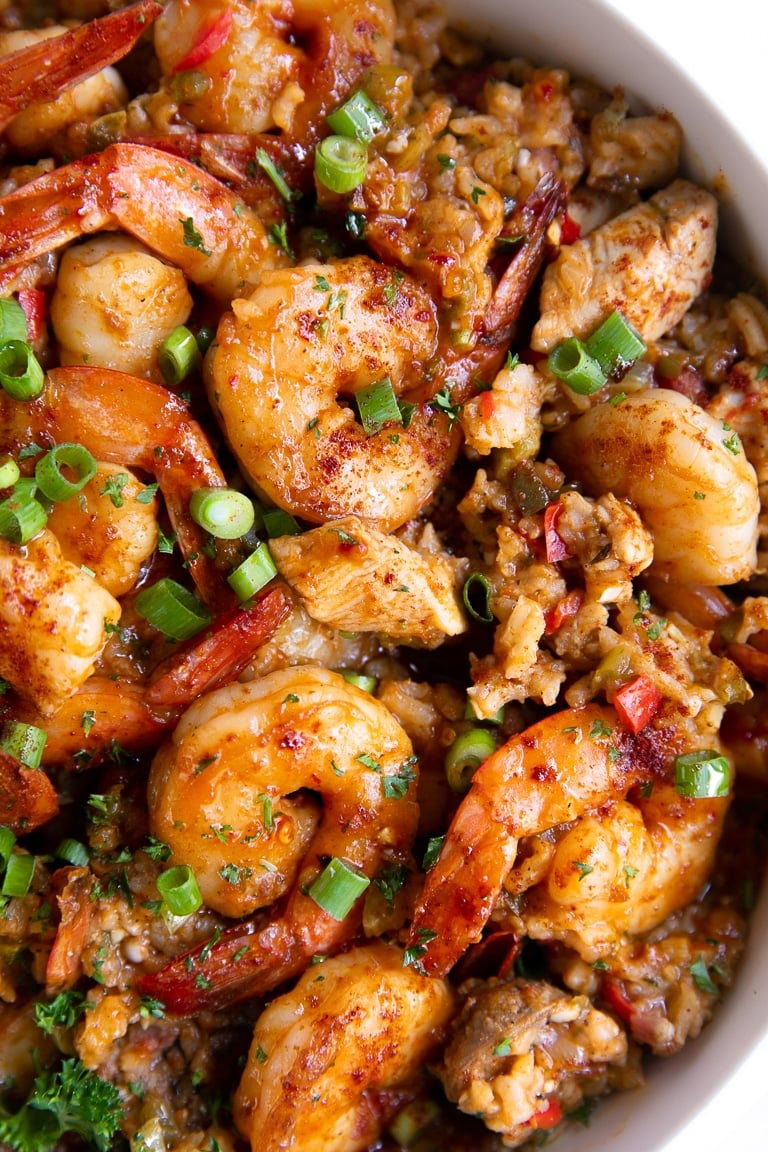
About the Ingredients
Below are notes and possible substitutions for the ingredients in this Jambalaya Recipe. You can find the printable recipe with measurements in the recipe card at the bottom of this page.
Vegetables: Sometimes referred to as the “holy trinity” of Cajun cooking, or simply “trinity,” it is an aromatic mixture consisting of finely diced onion, celery, and green or red bell pepper. It is the Cajun/Creole equivalent to French mirepoix or Spanish soffrito, a base made from finely diced vegetables (the mix of vegetables will vary by country and cuisine) that are cooked in butter or oil, low and slow as to sweeten the ingredients rather than caramelize them.
Meats: Jambalaya traditionally includes a mix of andouille sausage (smoked sausage), poultry, and seafood. This recipe includes all three, but andouille sausage is most common. Sometimes you’ll find jambalaya recipes containing duck, wild game, smoked ham, or tasso (spicy smoked pork).
- Andouille sausage: A smoked, heavily seasoned pork sausage originating from France. Possible substitutes include chorizo, kielbasa, smoked sausage.
Seafood (optional): Shrimp (and sometimes crawfish) are especially common in Creole versions of jambalaya. This recipe includes shrimp, but I’ve made it an optional ingredient. For best results, add the shrimp at the end of cooking to avoid overcooking.
Rice: The type of rice used in jambalaya plays a crucial role in its texture, flavor, and overall success. The best types of rice include long-grain white rice, such as Jasmine and Basmati, or American long-grain rice, such as Mahatma Extra Long Enriched Rice). You can also use parboiled rice, such as Zatarain’s Parboiled Long Grain Rice. It’s more resistant to overcooking but doesn’t absorb flavors as well.
- Rices that should not be used: Short-grain rice (e.g., sushi or arborio rice), brown rice, and Instant rice.
Cajun Seasoning and Spices: This recipe is flavored with Cajun seasoning, Italian seasoning, salt, and black pepper. For heat, I’ve included cayenne powder and red pepper flakes. Many store-bought Cajun seasoning mixes can be pretty spicy and salty, so add additional heat and salt with caution. If you are especially sensitive to spicy food, you may want to make your own homemade Cajun seasoning, adjusting the heat to taste. My go-to store-bought Cajun seasoning is Slap Ya Mama Cajun Seasoning.
- Cajun seasoning substitute: Creole seasoning can be used as a substitute for Cajun seasoning. Creole seasoning typically contains more herbs and is less spicy compared to Cajun seasoning.
Tomatoes: Tomatoes make this a Creole recipe. Tomatoes add natural sweetness and acidity and, perhaps more importantly, create a slightly saucy, moist consistency. Use fresh or canned tomatoes. If you don’t want the dish to feel too tomatoey, use a little tomato paste (about 1 tablespoon) instead of whole tomatoes.
Broth: I like using low-sodium chicken broth, but vegetable broth or water may also be used.
Okra (optional): As previously mentioned, okra is not traditional to jambalaya. I’ve included it because I like it; feel free to omit it for a more authentic recipe.
- Substitutions: Frozen okra (thaw before adding) or 1 teaspoon of file powder (added at the same time as the spices).
How to Make Jambalaya
Jump to RecipeBegin by preheating the oven to 350°F (if you plan to cook the rice in the oven vs. stovetop). Then, set a large heavy-bottomed pot or Dutch oven (I swear by my Lodge Enameled Cast Iron Dutch Oven) over medium heat. Add about a tablespoon of olive oil or butter and sear the sliced andouille sausage on both sides for approximately 1-2 minutes. Remove to a clean plate and set it aside. If you are using raw sausage (i.e., non-smoked sausage), cook your sausage whole first. Once it’s cooked, remove it from the pan, let it rest, and then slice before adding it to the pot.
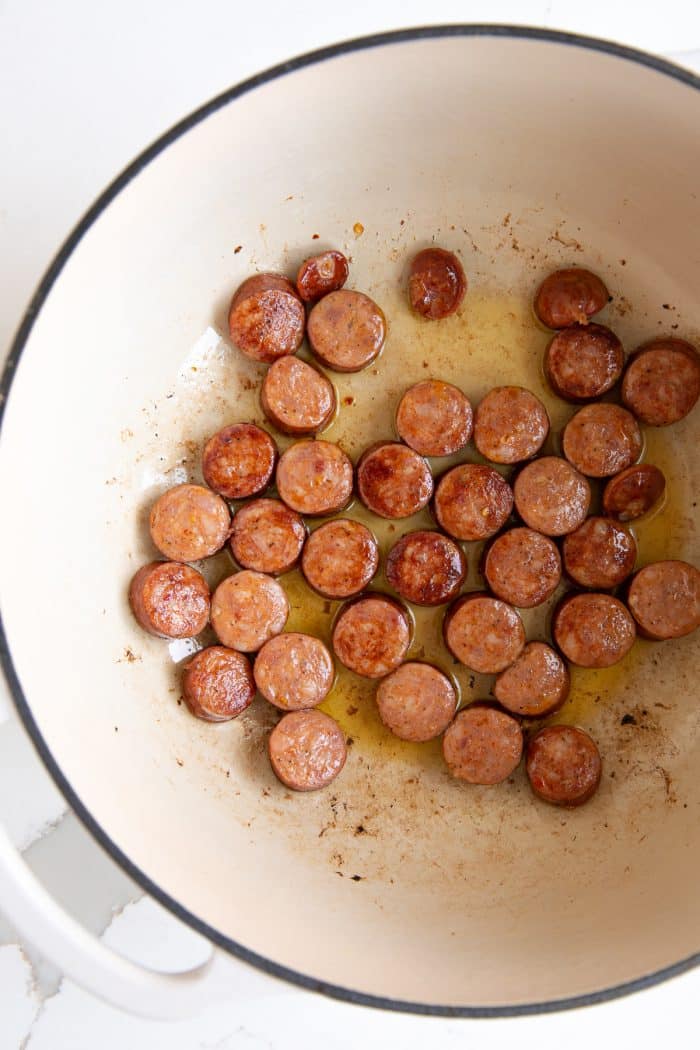
Add the chicken to a large bowl and season generously with salt, pepper, and about 1 tablespoon of Cajun seasoning. Set the same pot that was used to sear the sausage over medium-high heat. Cook the chicken until it registers 165°F (75°C), then remove it to a clean plate and set it aside.
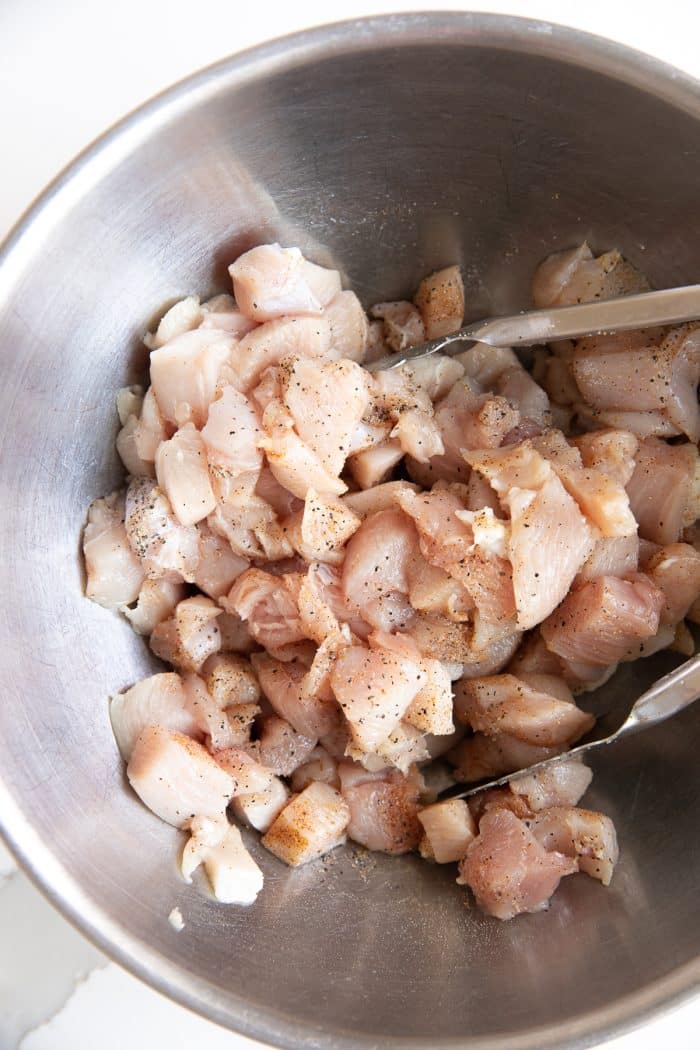
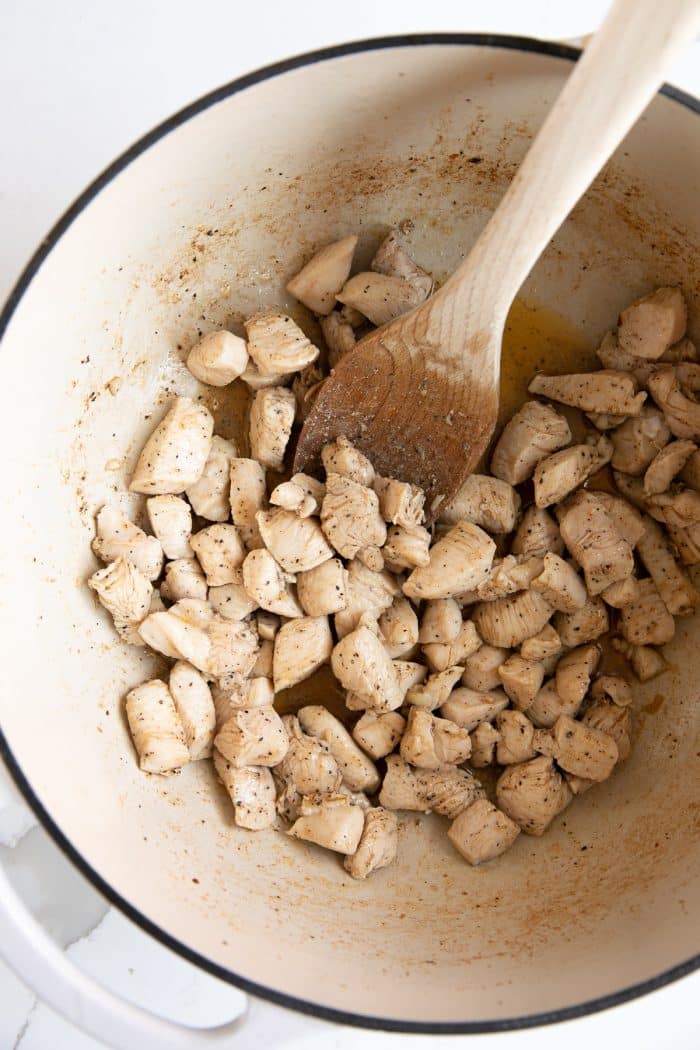
Return the same pot to medium heat and cook the the onions, bell peppers, and celery for 8-10 minutes, or until softened. Stir in the minced garlic, Cajun seasoning, Italian seasoning, salt, and black pepper. For extra-spicy jambalaya, add a little cayenne powder and/or red pepper flakes. Cook for a minute or so, stirring continuously.


Add the rice and liquid. Combine the canned tomatoes, Worcestershire sauce, white rice (thoroughly washed and drained), and low-sodium chicken broth. Bring to a boil, then immediately reduce to a simmer and cover.

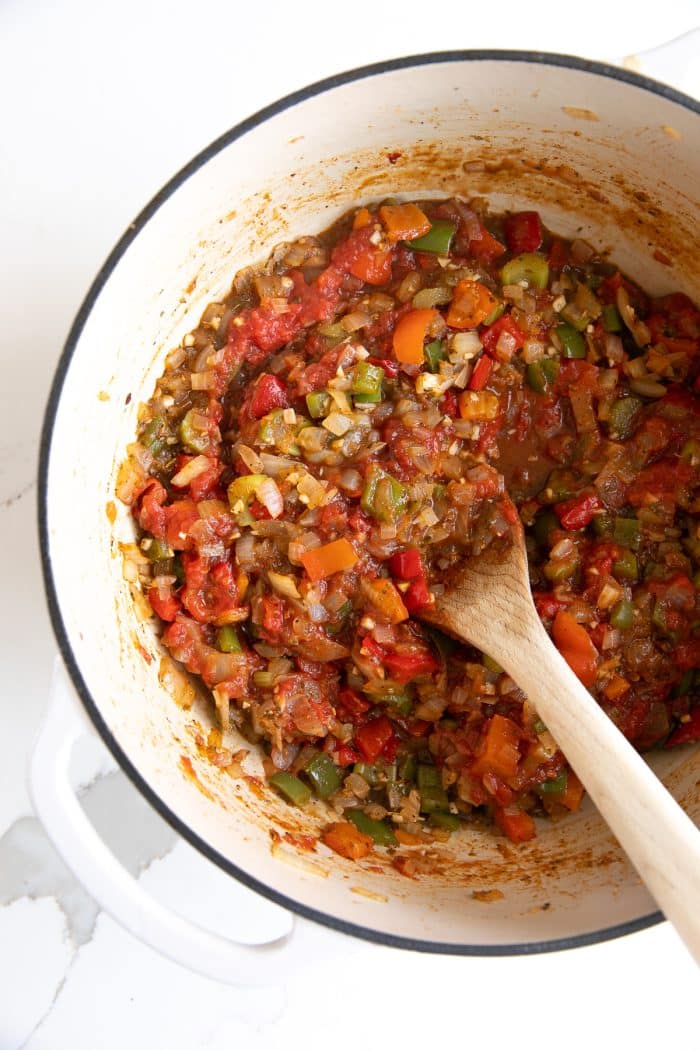
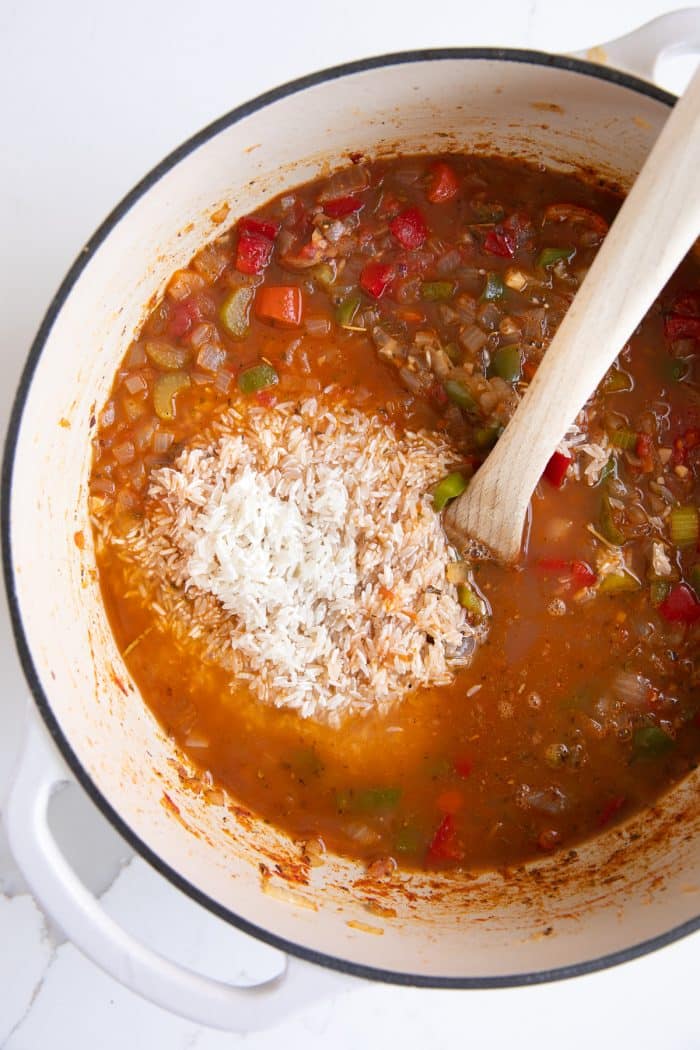
Cook the rice until al dente:
- Stovetop: Cook for approximately 25-30 minutes or until the rice is nearly cooked through. To prevent the rice from burning and sticking to the bottom of the pot, stir every 7-9 minutes.
- Oven: Transfer the covered pot to the oven and cook for approximately 25-35 minutes or until the rice is nearly cooked.
Note: Cooking time may vary. Factors that affect how long it will take for your rice to cook include the type of rice you use (parboiled rice takes longer to cook than regular long-grain white rice), altitude and air pressure, pot type, and lid handling.

As the rice cooks, sauté the shrimp in a hot skillet with two tablespoons of melted butter. Cooking the shrimp in a separate skillet is optional. It can also be added toward the end of cooking with the okra, chicken, and sausage (see next step). It will be cooked by the hot rice.
When the rice is nearly cooked, gently fold in the shrimp (if it hasn’t been cooked yet), sliced okra, cooked chicken, and sausage. Gently mix to combine. Cover and continue cooking over low heat (or in the oven) for 5-8 minutes.
Remove from heat. Season to taste and serve garnished with chopped parsley, hot sauce, and chopped green onions.


Tips and Troubleshooting
The perfect jambalaya rice should be fluffy and tender but in no way mushy or overly wet. The rice should absorb all broth without excess liquid pooling at the bottom of the pot. The grains should be slightly firm (al dente) but not hard or noticeably undercooked.
- Use long-grain white rice, such as basmati and jasmine rice, or American long-grain rice (such as Mahatma Extra Long Enriched Rice). You can also use parboiled rice as it’s more resistant to over-cooking, keeping in mind that it doesn’t absorb flavors as well and takes longer to cook.
- Rinse the rice before cooking to remove excess starch.
- Use the correct rice-to-liquid ratio – approximately 1 cup rice to 2 cups broth. However, if you are including tomatoes (as I suggest for this recipe), reduce the liquid slightly to account for the liquid in the tomatoes.
- Avoid over-stirring, and keep the lid on while cooking. Stirring too often causes the rice to release starch, making it gummy.
- Let it rest, covered, for at least 5-10 minutes after cooking. This allows the rice to fully absorb any remaining moisture.
- If you are at a high altitude, you may need to add a bit more liquid and cook for a longer time.
- If it is very humid, the rice may absorb more moisture. Reduce the liquid slightly.
- If your rice is undercooked, add a bit more warm broth, cover, and cook for 5-10 more minutes.
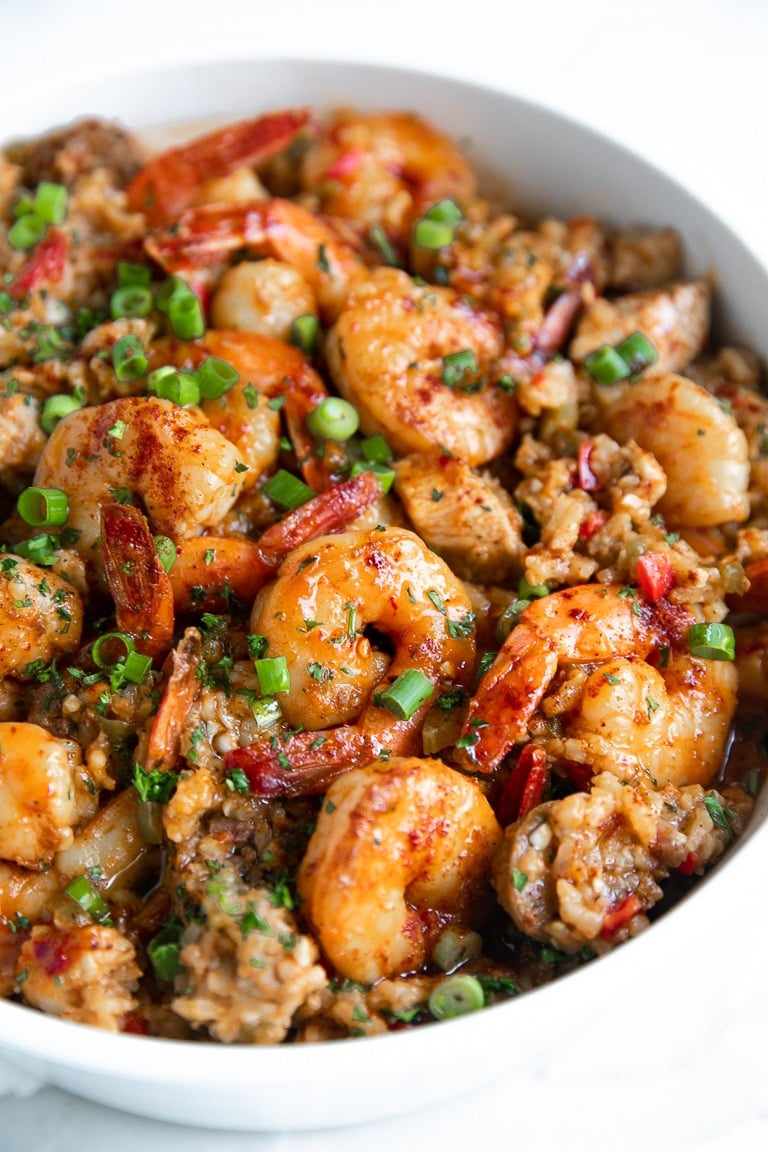
Storing and Freezing Tips
Let the leftovers cool for about an hour before transferring them to an airtight container. Refrigerate for up to 4 days.
Before freezing, be aware that freezing may cause the rice to soften and become mushy, and the shrimp will become chewy. To freeze, let the jambalaya cool completely before dividing it into single-serving portions in freezer-safe bags or containers. Remove excess air (if possible) to prevent freezer burn, and place in the freezer for up to 2 months.
Reheat leftovers on the stovetop or in the microwave. Stovetop: Heat it in a large skillet set over medium-low heat with 1-2 tablespoons of water or broth. Stir occasionally until warmed through. Microwave: Add the leftovers to a microwave-safe bowl with a splash of water or broth. Cover with a damp paper towel and heat for 1-2 minutes, stirring midway through cooking.

Have any questions? Drop me a message in the comment section below! I’m happy to help. And, if you enjoy this recipe, please rate it with some STAR LOVIN’ so other readers know to try it too! Tag me at #theforkedspoon. I’ll be sure to share! Thank you!
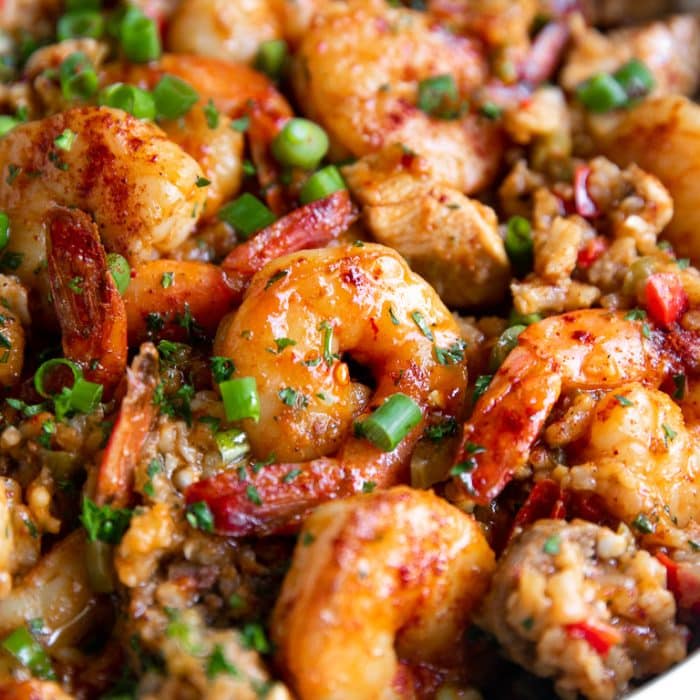
Jambalaya Recipe
Ingredients
- 3 tablespoon olive oil, divided
- 1 pound Andouille sausage, (or any smoked sausage)
- 1½ pounds boneless skinless chicken breasts or thighs, chopped into 1-inch cubes
- 3 tablespoon Cajun seasoning, divided and adjusted to suit your own personal taste/heat preference
- 2 medium yellow onions, diced
- 1 green bell pepper, seeded and diced
- 1 red bell pepper, seeded and diced
- 3 stalks celery, diced
- 6 cloves garlic, minced
- 1 teaspoon salt
- 1 teaspoon pepper
- ½ teaspoon cayenne, optional, omit if you're sensitive to spicy food
- 1 tablespoon Italian seasoning
- 1 teaspoon red pepper flakes, optional, omit if you're sensitive to spicy food
- 1 (14 ounce) can diced/crushed tomatoes
- 2 teaspoon Worcestershire sauce
- 1½ cups uncooked long-grain white rice, rinsed and drained thoroughly
- 2¾ cups low sodium chicken broth
- 1 cup okra, thinly sliced (or 1 tsp file powder), optional
- 1 pound raw shrimp, thawed, peeled, and deveined
- fresh chopped parsley, to garnish
- chopped green onion, to garnish
Instructions
- Preheat oven to 350 degrees F (180 degrees C).
- Add 1 tablespoon of olive oil to a large stockpot or Dutch oven set over medium-high heat. Add the sliced sausage and cook for approximately 1 minute per side. Remove to a clean plate and set aside. Note: If you are using raw sausage (i.e., non-smoked sausage), cook the sausage whole first. Once it’s cooked, remove it from the pan, let it rest, and then slice it before adding it to the pot.
- Add the chicken to a large bowl and season with salt, pepper, and about 1 tablespoon of Cajun seasoning. Set the same pot used to sear the sausage over medium-high heat. Add 1 more tablespoon of olive oil and add the chicken. Cook, stirring occasionally, for 6-8 minutes or until it registers 165°F (75°C) with a digital meat thermometer. Transfer the chicken to a clean plate and set aside.
- Add the last tablespoon of olive oil to the pot and set it over medium-low heat. Add the finely chopped onions, bell pepper, and celery, mixing well to combine. Cook for 8-10 minutes, stirring frequently, until softened.
- Add the minced garlic, Cajun seasoning, salt, pepper, cayenne pepper (optional), Italian season, and red pepper flakes (optional). Mix well to combine and continue to cook for an additional minute.
- Mix in the crushed tomatoes, Worcestershire sauce, white rice, and low-sodium chicken broth with the softened veggies. Mix well to combine. Bring to a boil, then immediately reduce the heat to low and cover with a tight-fitting lid.
- Cook for approximately 25-35 minutes or until the rice is nearly cooked, gently stirring every 7-8 minutes to prevent the rice from burning and sticking to the bottom of the pot. To cook the rice in the oven, transfer the covered pot to the preheated oven and bake for approximately 25-35 minutes or until the rice is nearly cooked.
- As the rice cooks, melt 2 tablespoons of butter in a large skillet set over medium-high heat and cook the shrimp for 2 minutes on each side.Note: Cooking the shrimp in a separate skillet is optional. You can add the uncooked shrimp with the okra, chicken, and sausage (see next step). The hot rice will cook the raw shrimp.
- When the rice is nearly finished cooking, stir in the shrimp and the sliced okra, and return the chicken and sausage back to the pot. Gently mix to combine with the rice. Continue to cook on low, stirring as needed, until the shrimp is cooked, approximately 5-8 minutes.
- Remove from heat. Serve warm garnished with chopped parsley and green onion if desired. Refrigerate leftovers in a sealed container for up to 4 days. Enjoy!
Video
Notes
- Meat & Seafood: Depending on the type (Creole/Cajun) of jambalaya, it may contain a mix of andouille sausage (smoked sausage), poultry, wild game, and seafood, such as shrimp or crawfish. On a scale of most to least important, Andouille sausage is at the top, with seafood at the bottom.
- Rice: The best types of rice for jambalaya are long-grain white rice, like Jasmine and Basmati, or American long-grain rice (Mahatma Extra Long Enriched Rice). You can also use parboiled rice, such as Zatarain’s Parboiled Long Grain Rice. It’s more resistant to overcooking but doesn’t absorb flavors as well. Rice that should not be used include any short-grain rice (e.g., sushi or arborio rice), brown rice, and Instant rice.
- Seasoning and Spices: Many store-bought Cajun seasoning mixes can be pretty spicy and salty, so add additional heat and salt with caution. If you are especially sensitive to spicy food, you may want to make your own homemade Cajun seasoning, adjusting the heat to taste. My go-to store-bought Cajun seasoning is Slap Ya Mama Cajun Seasoning. Yes, Creole seasoning can be used as a substitute for Cajun seasoning.
- Okra: Okra is optional and not traditional to jambalaya. I’ve included it because I like it; feel free to omit it for a more authentic recipe. If using frozen okra, thaw it completely before adding it.
- Use the right type of rice (see above).
- Rinse the rice before cooking.
- Use the correct 1:2 rice-to-liquid ratio. However, if you are including tomatoes (as I suggest for this recipe), reduce the liquid slightly to account for the liquid in the tomatoes.
- Avoid over-stirring, and keep the lid on while cooking.
- Let it rest, covered, for 5-10 minutes after cooking.
- Thaw the shrimp (and okra if using frozen) before adding it to the cooked rice.
- If you are at a high altitude, you may need to add a bit more liquid and cook for a longer time.
- If it is very humid, the rice may absorb more moisture. Reduce the liquid slightly.
- If your rice is undercooked, add a bit more warm broth, cover, and cook for 5-10 more minutes.
- Let the leftovers cool for about an hour before transferring them to an airtight container. Refrigerate for up to 4 days.
- Note: Freezing may cause the rice to soften and become mushy and the shrimp to become chewy.
- To freeze, cool completely, divide it into single-serving portions, and transfer it to freezer-safe bags or containers. Remove excess air (if possible) to prevent freezer burn, and freeze for up to 2 months.
Nutrition
Nutrition information is automatically calculated, so should only be used as an approximation.
Check out my other favorite Cajun and Creole-inspired recipes, including Gumbo, Shrimp Étouffée, and this spicy Cajun Remoulade Sauce.
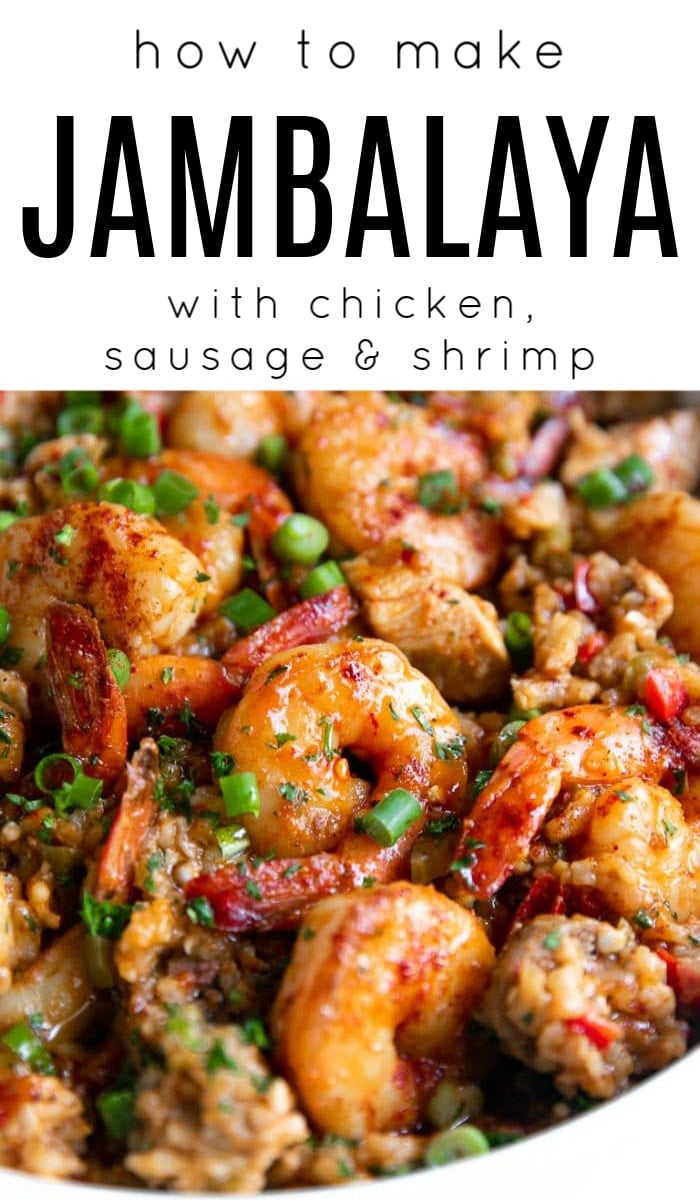
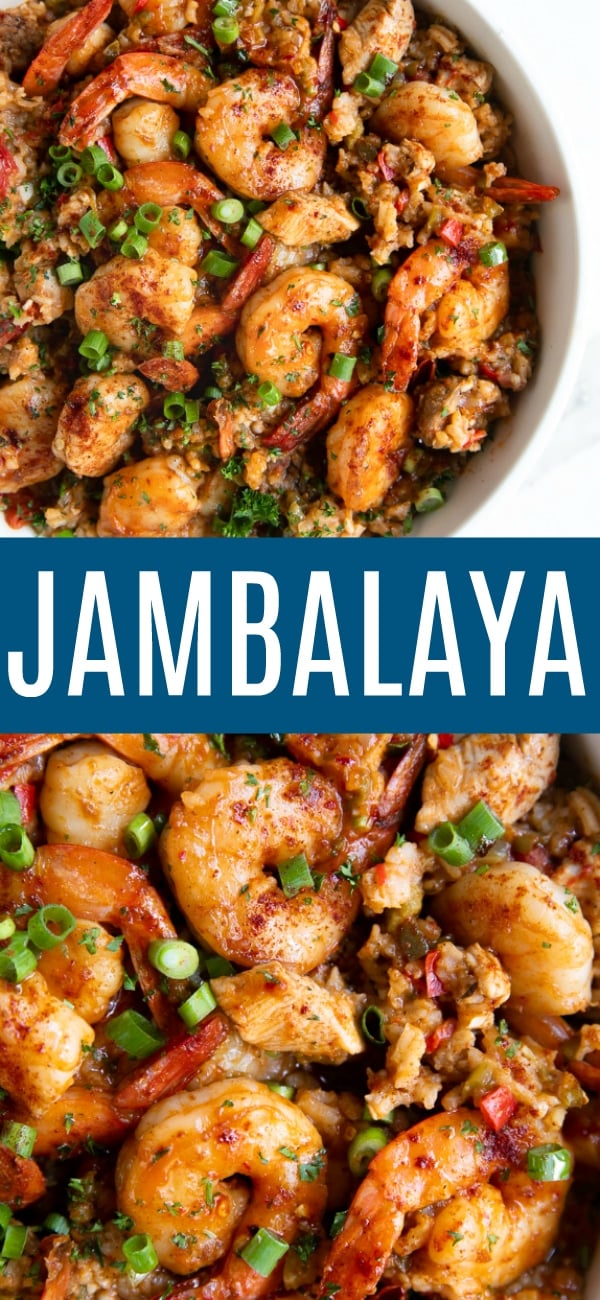
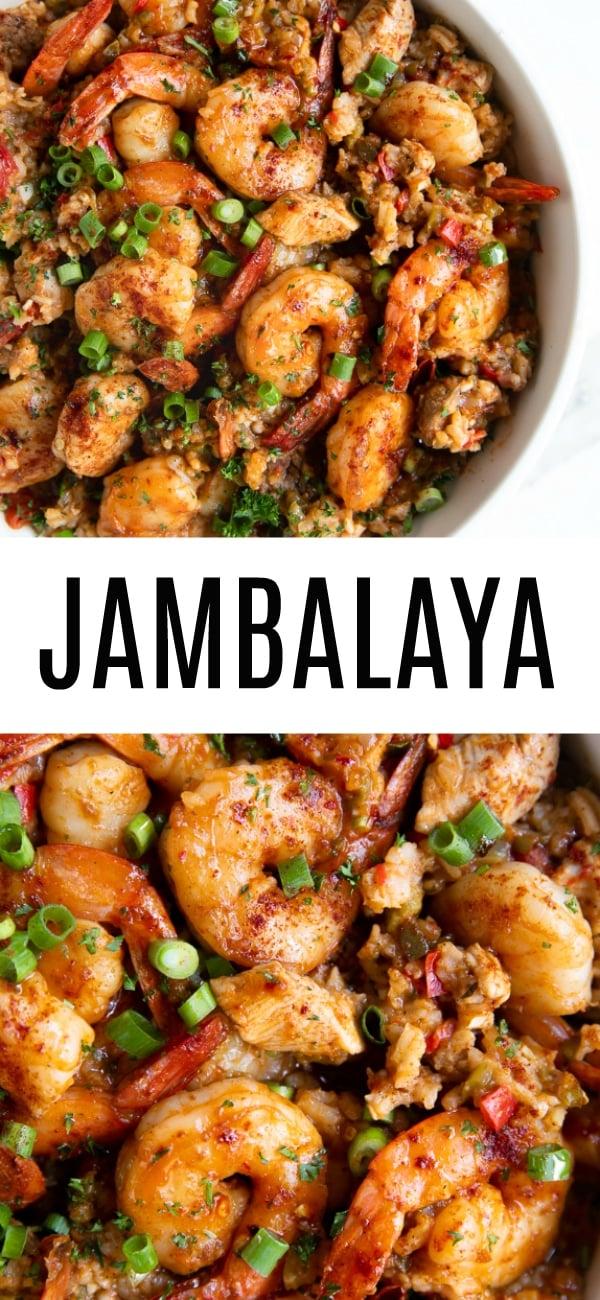
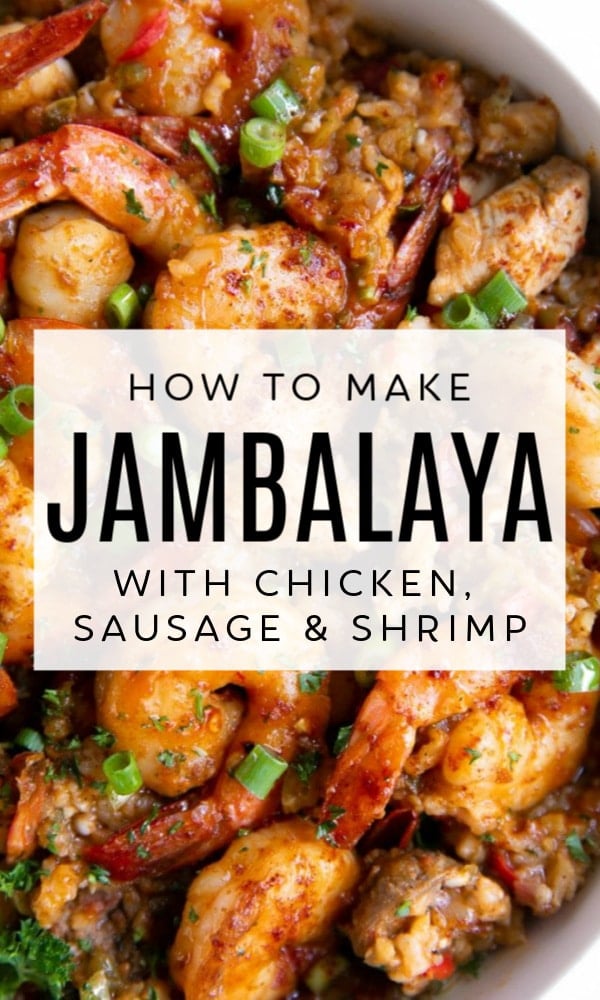
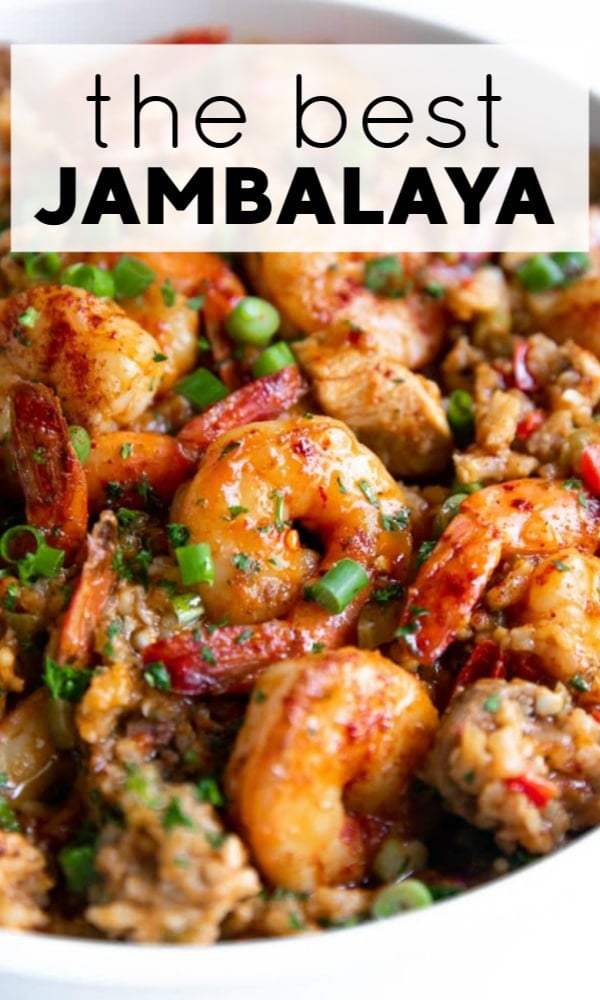
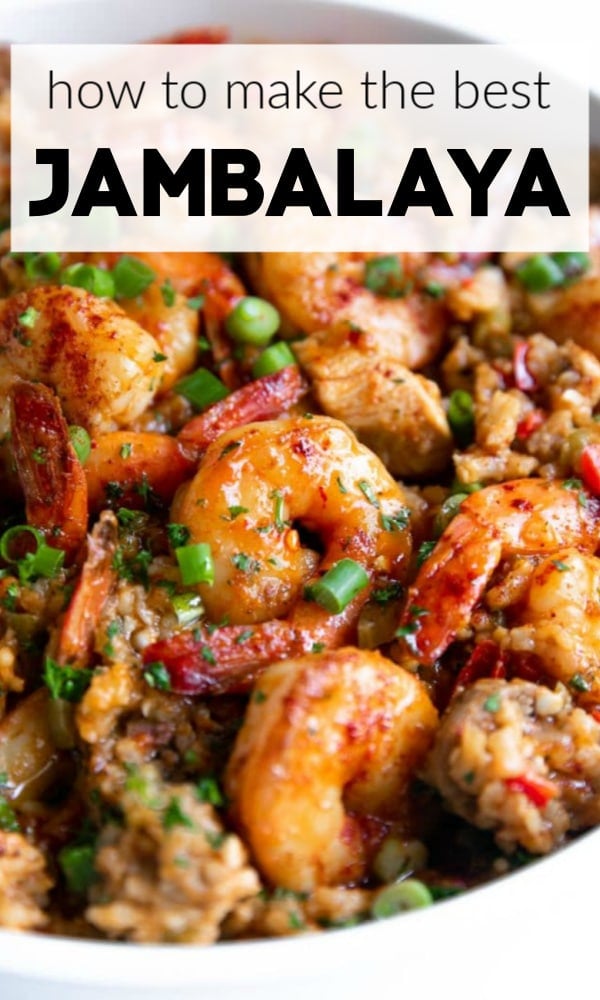


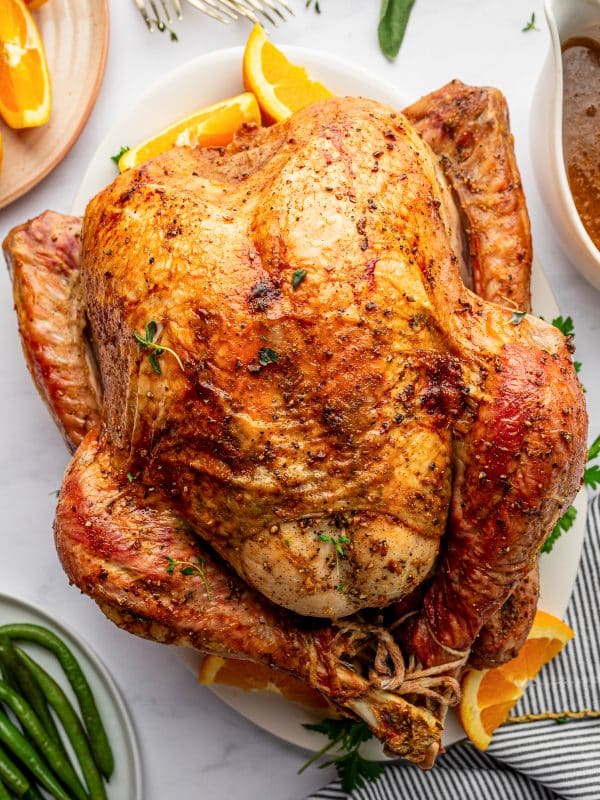
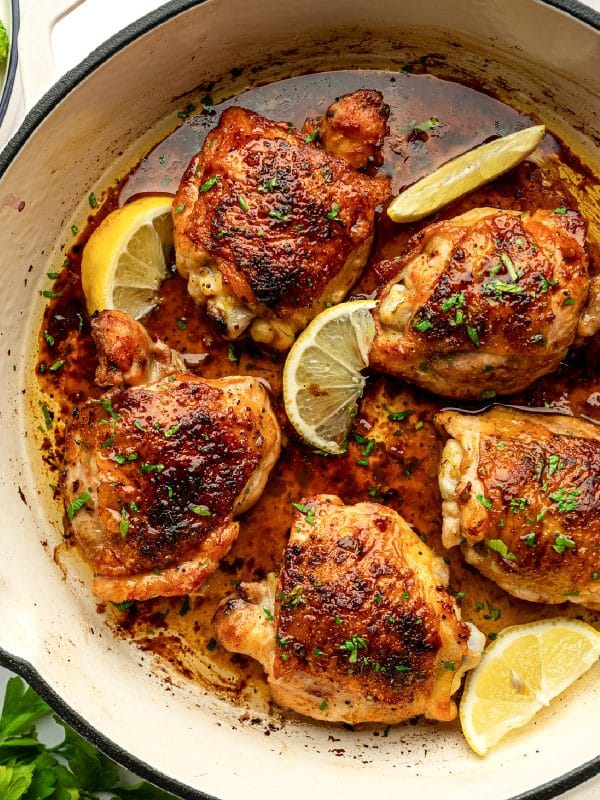
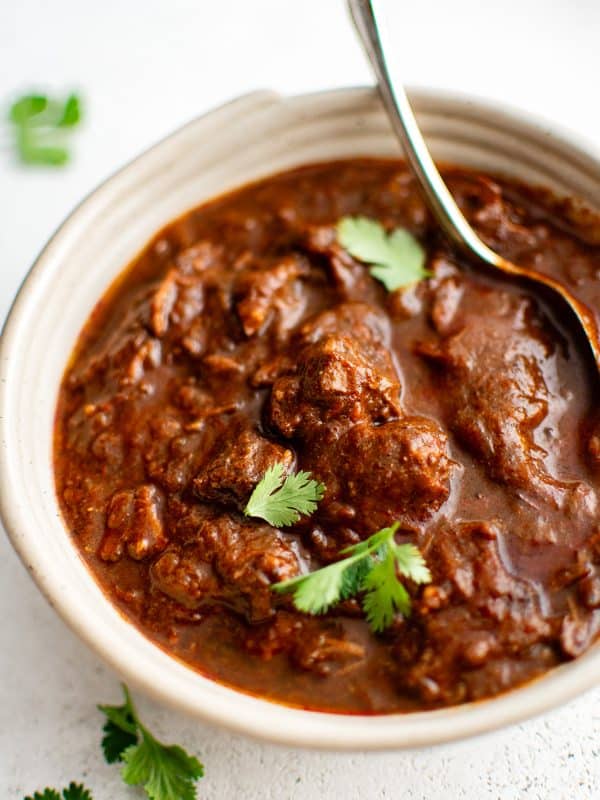
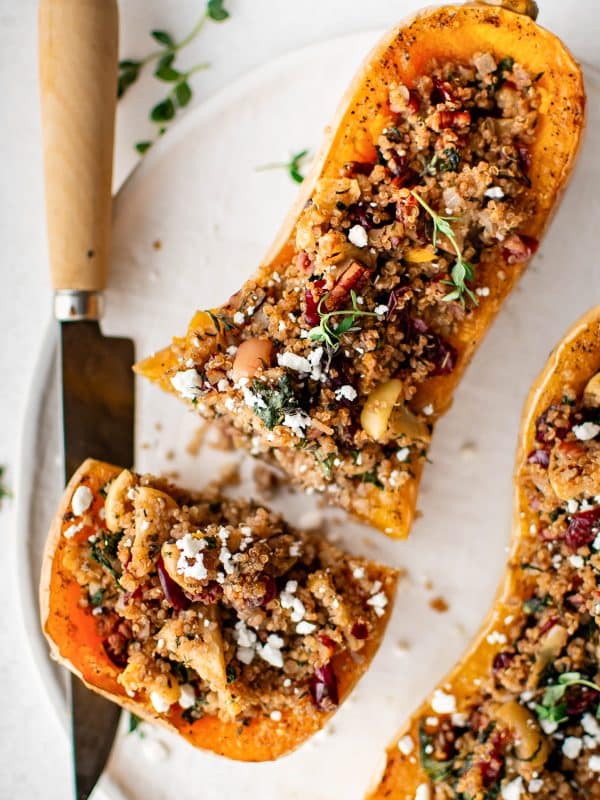








Thought I’d follow up after making this amazing jambalaya for family birthday dinner for 14. Made my own Cajun/creole spice blend as it needed to be dialed back for the lightweights and kids in the group and doubled the recipe in two enameled cast iron pots as you suggested. Dinner a huge hit with rave reviews all around. Thank you so much for this wonderful recipe, will definitely make this again
Thank you so much for coming back to share this, I am thrilled it was such a hit for the birthday dinner! Doubling it in two enameled pots and dialing back the spice with your own blend is exactly how I would tackle a big mixed crowd, and I am so happy to hear it got rave reviews.
The steps are confusing. Do you cook the rice on the stove top then transfer to oven to cook or is it one or the other? same for the shrimp, it says optional so at least that makes more sense to either cook in a separate pan versus in the rice microwave mixture
Great question, thank you for asking! You can choose either method for the rice – cook it fully on the stovetop or transfer the covered pot to the oven to finish, but you do not need to do both. For the shrimp, you can sauté them separately in a skillet or add them in raw with the okra, chicken, and sausage near the end; the hot rice will cook them through.
Questions: 1. do you prefer your season blend or usually use commercial brand ( slap yo mama?) 2.if using parboiled rice, do you recommend rinsing? 3. Planning on making double recipe for family birthday dinner. Would 2 pots be better than one larger pot? Thanks so much! Can’t wait to try this!
Thank you so much, I am excited you are making it for a birthday dinner! I usually reach for my own homemade seasoning blend, but a commercial one like Slap Ya Mama works great too – just start with a little less and add to taste since store-bought blends can be saltier. If you are using parboiled rice, a quick rinse is fine but not strictly necessary; just don not soak it. And for a double batch, I would definitely lean toward using two pots unless you have an extra-large, heavy pot with plenty of room so the rice cooks evenly.